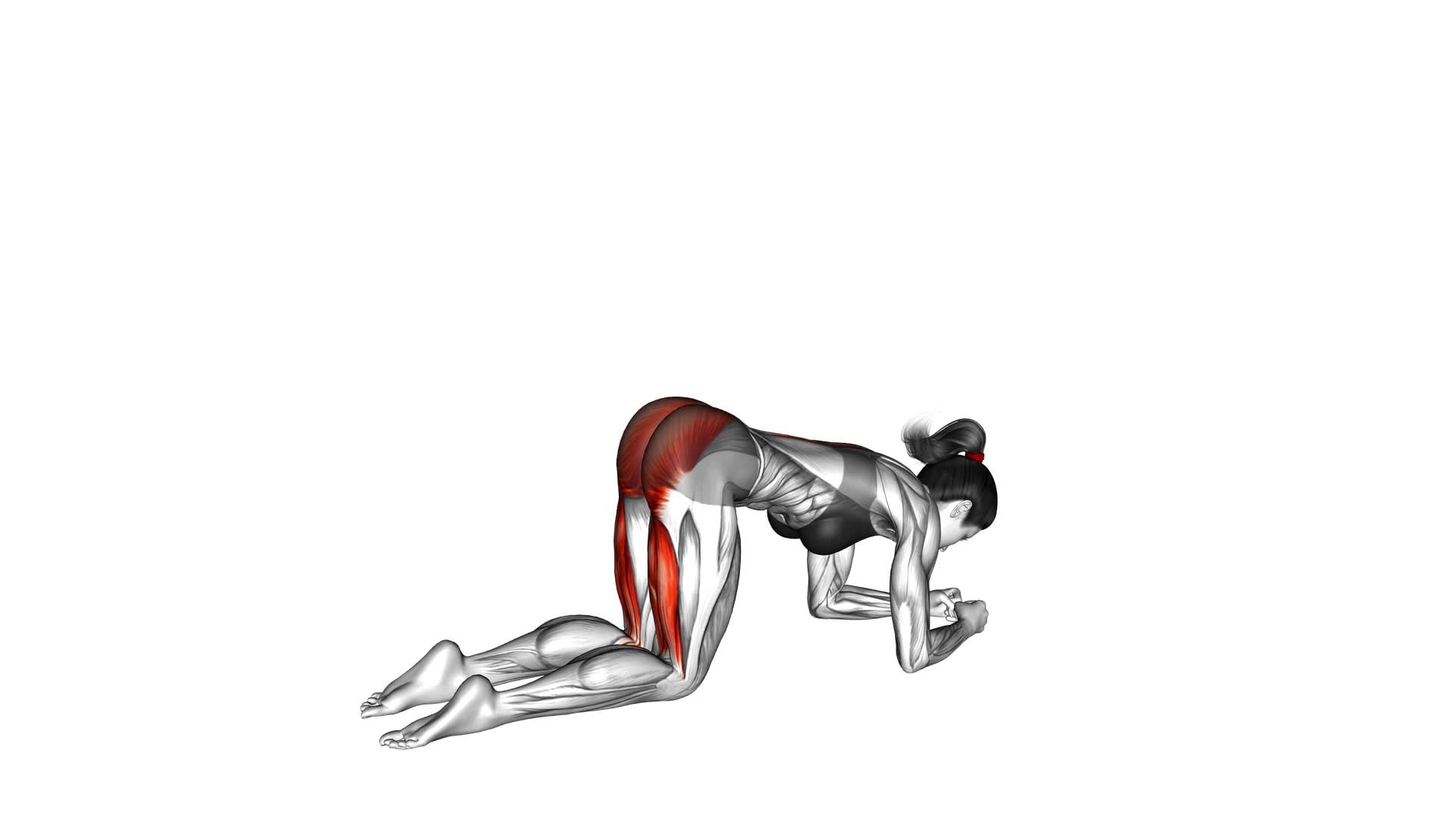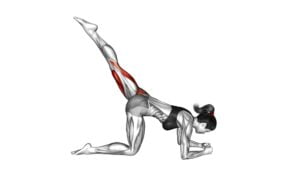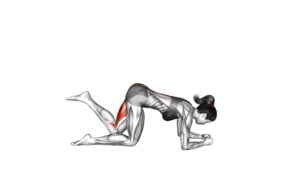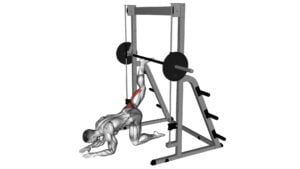Alternate Donkey Kick (female) – Video Exercise Guide & Tips

Get ready to tone your glutes with the alternate donkey kick! This video exercise guide and tips will help you master this effective move.
Watch This Exercise Video
You'll learn the benefits, proper form, and equipment needed for the exercise.
Whether you're a beginner or advanced, modifications are available.
Stay on track by avoiding common mistakes and maximize your results with these expert tips.
It's time to kick your fitness routine up a notch!
Key Takeaways
- The alternate donkey kick strengthens the glutes and improves core stability.
- It targets the gluteus maximus, the largest muscle in the buttocks.
- Incorporating this exercise into your routine can lead to stronger glutes and improved core stability.
- Proper form and technique, as well as core engagement, are important to avoid lower back strain.
Benefits of the Alternate Donkey Kick
Get stronger glutes and improve core stability with the Alternate Donkey Kick exercise. This exercise is highly effective in improving glute strength and can be done in various variations.
The primary focus of the Alternate Donkey Kick is to target the gluteus maximus, the largest muscle in your buttocks, which helps in hip extension and overall lower body strength. By performing this exercise, you won't only strengthen your glutes but also enhance your core stability.
To begin, get down on all fours with your hands directly below your shoulders and your knees below your hips. Keep your back straight and engage your core muscles. Start by lifting one leg off the ground, keeping it bent at a 90-degree angle. Then, kick your leg backward, extending it fully until your thigh is parallel to the ground. Slowly return to the starting position and repeat the movement with the opposite leg.
To increase the difficulty and target different areas of the glutes, you can try variations of the Alternate Donkey Kick. For instance, you can perform the exercise with ankle weights or resistance bands wrapped around your thighs. Additionally, you can try lifting your leg out to the side instead of straight back, targeting the gluteus medius, the muscle responsible for hip abduction.
Incorporating the Alternate Donkey Kick exercise into your workout routine will help you achieve stronger glutes and improved core stability.
Proper Form and Technique
To perform the Alternate Donkey Kick with proper form and technique, it's important to focus on engaging your core during the kick and to avoid straining your lower back.
By engaging your core, you'll maintain stability and control throughout the movement, maximizing its effectiveness.
Additionally, be mindful of your lower back position, keeping it neutral and avoiding any excessive arching or rounding.
Core Engagement During Kick
Ensure proper core engagement during the alternate donkey kick by maintaining a strong abdominal contraction throughout the exercise. This will help improve core stability and maximize muscle activation.
Here are three key tips to ensure proper core engagement:
- Start by lying face down on a mat, with your elbows directly under your shoulders and your forearms on the ground.
- Engage your core by drawing your belly button in towards your spine and squeezing your glutes.
- As you lift one leg off the ground, keep your core tight to prevent your lower back from arching or sagging.
Avoiding Lower Back Strain
Maintain proper form and technique to avoid lower back strain during the alternate donkey kick exercise. Preventing injury and strengthening your glutes are crucial when performing this exercise.
To ensure proper form, start by positioning yourself on all fours, with your hands directly under your shoulders and knees under your hips. Engage your core muscles by drawing your belly button towards your spine. As you lift one leg back, keep your hips level and avoid arching your lower back. Focus on squeezing your glutes to lift your leg, rather than relying on momentum. Gradually increase the height and range of motion as you build strength and flexibility.
By following these guidelines, you can effectively target your glutes while minimizing the risk of lower back strain.
Now, let's move on to the equipment needed for the exercise.
Equipment Needed for the Exercise
You'll need some equipment to perform the Alternate Donkey Kick exercise. Here are the items you'll need:
- Resistance Bands: These bands provide the necessary resistance to target and strengthen your glutes. There are different types of resistance bands available, such as loop bands, tube bands, and figure-eight bands. Loop bands are versatile and can be used for a variety of exercises, while tube bands offer more resistance options. Figure-eight bands are ideal for targeting specific muscle groups.
- Exercise Mat: An exercise mat provides cushioning and support for your knees and elbows during the exercise. It prevents discomfort and minimizes the risk of injury. Look for a mat that's thick enough to provide adequate padding and non-slip to ensure stability during the exercise.
- Alternative Options: If you don't have access to resistance bands or an exercise mat, don't worry! You can still perform the Alternate Donkey Kick exercise. Instead of resistance bands, you can use ankle weights or even household items like water bottles or cans for added resistance. If you don't have an exercise mat, you can use a towel or a soft surface to protect your knees and elbows.
Modifications for Beginners and Advanced Levels
To modify the Alternate Donkey Kick exercise for beginners and advanced levels, try incorporating variations that challenge different muscle groups.
For beginners, start by performing the exercise on all fours, with your hands directly under your shoulders and your knees under your hips. Instead of extending your leg straight back, bend your knee and kick your foot up towards the ceiling. This modification reduces the intensity and allows you to focus on building strength and stability in your glutes and hamstrings.
For advanced modifications, you can add resistance by using ankle weights or resistance bands. Attach the ankle weights or bands to your ankles and perform the donkey kicks as usual. This increases the difficulty and engages your muscles even more. You can also try the exercise on an unstable surface, such as a BOSU ball or a stability ball. This challenges your balance and core muscles while targeting your glutes and hamstrings.
By incorporating these beginner and advanced modifications, you can customize the Alternate Donkey Kick exercise to your fitness level and goals.
Now, let's move on to the next section and discuss some common mistakes to avoid when performing this exercise.
Common Mistakes to Avoid
Avoid these common mistakes when performing the Alternate Donkey Kick exercise to ensure proper form and maximize results. By avoiding these mistakes, you can minimize the risk of injury and ensure optimal muscle activation during this exercise.
- Not engaging your core: One common mistake is failing to engage your core muscles throughout the movement. This can lead to strain in your lower back and diminish the effectiveness of the exercise. To avoid this, focus on keeping your core tight and stable throughout the entire motion.
- Incorrect leg positioning: Another mistake isn't positioning your legs properly. Make sure your standing leg is slightly bent and your weight is evenly distributed. Additionally, ensure that your kicking leg is fully extended and parallel to the ground, with your foot flexed.
- Using momentum instead of control: Many people make the mistake of using momentum to perform the donkey kick, rather than relying on controlled movements. This can reduce muscle activation and increase the risk of injury. Instead, focus on using your glutes to lift your leg and maintain control throughout the exercise.
Tips for Maximizing Results
To further enhance your results, focus on incorporating these tips into your Alternate Donkey Kick exercise routine. Maximizing intensity is key to achieving the best results from this exercise. Start by engaging your core muscles throughout the entire movement. This won't only strengthen your core but also help stabilize your body during the exercise. Additionally, when performing the kick, make sure to fully extend your leg and squeeze your glutes at the top of the movement. This will increase the intensity and target your glute muscles more effectively.
To vary the muscle groups targeted, you can try different variations of the Alternate Donkey Kick. For example, to focus more on your hamstrings, you can perform the exercise with a resistance band around your ankles. This will provide extra resistance and challenge your hamstrings. If you want to target your inner thighs, try performing the exercise with a wider stance, turning your toes outward slightly. This will activate your adductor muscles more effectively.
Remember to always maintain proper form and control throughout the exercise. Avoid using momentum or swinging your leg to ensure that you're working the targeted muscles effectively.
Frequently Asked Questions
How Many Calories Can You Burn by Doing the Alternate Donkey Kick Exercise?
You can burn calories and enjoy fitness benefits by doing the alternate donkey kick exercise. This exercise targets your glutes, hamstrings, and core muscles, helping to strengthen and tone them.
While the exact number of calories burned depends on factors like your weight and intensity, the alternate donkey kick is a dynamic move that can increase your heart rate and contribute to calorie burning.
Incorporating this exercise into your fitness routine can help you achieve your weight loss goals.
Can the Alternate Donkey Kick Exercise Help in Reducing Cellulite?
The alternate donkey kick exercise is a great addition to your fitness routine, offering numerous benefits for overall fitness. While it may not directly target cellulite reduction, it can help tone and strengthen your glutes, hamstrings, and core muscles.
By incorporating different variations of the exercise, such as using resistance bands or ankle weights, you can increase the challenge and further enhance muscle engagement.
Remember to maintain proper form and consult with a fitness professional for personalized advice.
Is It Necessary to Warm up Before Performing the Alternate Donkey Kick Exercise?
Is a warm-up essential before doing the alternate donkey kick exercise? Absolutely! Warming up before any exercise helps prepare your muscles and joints for the upcoming workout. It increases blood flow, enhances flexibility, and reduces the risk of injury.
As for the benefits of incorporating the alternate donkey kick into your routine, it targets your glutes, hamstrings, and core, helping to strengthen and tone those areas. Plus, it can improve your overall stability and balance.
Can the Alternate Donkey Kick Exercise Help in Strengthening the Core Muscles?
Yes, the alternate donkey kick exercise can help in strengthening your core muscles. By engaging your abdominal and lower back muscles to stabilize your body during the movement, this exercise can improve balance and stability.
Additionally, the alternate donkey kick exercise targets the glute muscles effectively, helping to tone and strengthen them.
Incorporating this exercise into your workout routine can provide multiple benefits for your overall strength and stability.
Can the Alternate Donkey Kick Exercise Be Performed by Individuals With Knee Injuries?
Yes, the alternate donkey kick exercise can be modified for individuals with knee injuries.
If you're recovering from an ACL injury or have knee issues, there are a few modifications you can make to ensure a safe and effective workout.
It's important to consult with a healthcare professional or a certified trainer who can guide you through the proper modifications and help you strengthen your core muscles without causing further harm to your knees.
Conclusion
In conclusion, the alternate donkey kick is a highly effective exercise that targets the glutes, hamstrings, and lower back muscles.
By maintaining proper form and using the appropriate equipment, you can maximize your results and avoid common mistakes.
Whether you're a beginner or at an advanced level, modifications can be made to suit your fitness level.
Incorporating this exercise into your routine can help you strengthen and tone your lower body, leading to improved overall strength and stability.

Author
Years ago, the spark of my life’s passion ignited in my mind the moment I stepped into the local gym for the first time. The inaugural bead of perspiration, the initial endeavor, the very first surge of endorphins, and a sense of pride that washed over me post-workout marked the beginning of my deep-seated interest in strength sports, fitness, and sports nutrition. This very curiosity blossomed rapidly into a profound fascination, propelling me to earn a Master’s degree in Physical Education from the Academy of Physical Education in Krakow, followed by a Sports Manager diploma from the Jagiellonian University. My journey of growth led me to gain more specialized qualifications, such as being a certified personal trainer with a focus on sports dietetics, a lifeguard, and an instructor for wellness and corrective gymnastics. Theoretical knowledge paired seamlessly with practical experience, reinforcing my belief that the transformation of individuals under my guidance was also a reflection of my personal growth. This belief holds true even today. Each day, I strive to push the boundaries and explore new realms. These realms gently elevate me to greater heights. The unique combination of passion for my field and the continuous quest for growth fuels my drive to break new ground.







